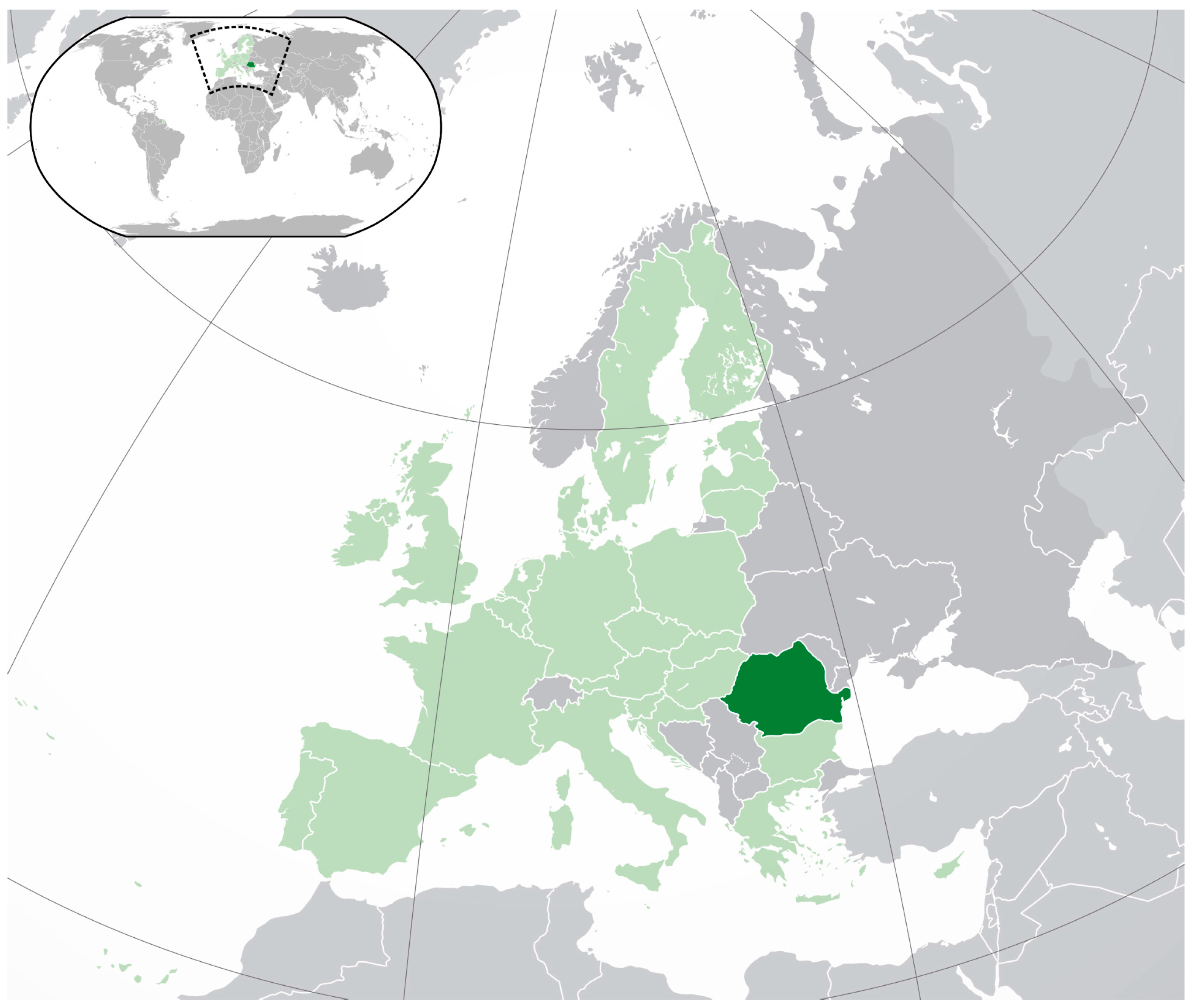The Burden of Fungal Diseases in Romania
Abstract
:1. Introduction
2. Materials and Methods
3. Results
3.1. Cryptococcal Meningitis and Pneumocystis Pneumonia
3.2. Pulmonary Aspergillosis
3.3. Mucormycosis
3.4. Allergic Bronchopulmonary Diseases
3.5. Invasive Candidiasis
3.6. Superficial Candidiasis
4. Discussion
5. Conclusions
Acknowledgments
Author Contributions
Conflicts of Interest
References
- The Free Encyclopedia. Available online: https://en.wikipedia.org/wiki/Romania (accessed on 26 January 2018).
- Bongomin, F.; Gago, S.; Oladele, R.O.; Denning, D.W. Global and Multi-National Prevalence of Fungal Diseases-Estimate Precision. J. Fungi 2017, 3, 57. [Google Scholar] [CrossRef] [PubMed]
- National Institute of Statistics. Romania in Figures—Statistical Abstract; National Institute of Statistics: Bucharest, Romania, 2017; pp. 1–98.
- National Institute of Statistics. Demographic Events in 2016; National Institute of Statistics: Bucharest, Romania, 2017; pp. 1–75.
- Sobel, J.D. Vulvovaginal candidosis. Lancet 2007, 369, 1961–1971. [Google Scholar] [CrossRef]
- Foxman, B.; Muraglia, R.; Dietz, J.; Sobel, J.D. Prevalence of recurrent vulvovaginal candidiasis in 5 European countries and the United States: Results from an internet panel survey. J. Low. Genit. Tract Dis. 2013, 17, 340–345. [Google Scholar] [CrossRef] [PubMed]
- Evolution of HIV/AIDS Infection in Romania—31 December 2016 (Romanian Version). Available online: http://www.cnlas.ro/images/doc/31122016_rom.pdf (accessed on 9 January 2018).
- Matee, M.I.; Scheutz, F.; Moshy, J. Occurrence of oral lesions in relation to clinical and immunological status among HIV-infected adult Tanzanians. Oral Dis. 2000, 6, 106–111. [Google Scholar] [CrossRef] [PubMed]
- Smith, E.; Orholm, M. Trends and patterns of opportunistic diseases in Danish AIDS patients 1980–1990. Scand. J. Infect. Dis. 1990, 22, 665–672. [Google Scholar] [CrossRef] [PubMed]
- Buchacz, K.; Baker, R.K.; Palella, F.J., Jr.; Chmiel, J.S.; Lichtenstein, K.A.; Novak, R.M.; Wood, K.C.; Brooks, J.T.; HOPS Investigators. AIDS-defining opportunistic illnesses in US patients, 1994–2007: A cohort study. AIDS 2010, 24, 1549–1559. [Google Scholar] [CrossRef] [PubMed]
- Arendrup, M.C. Epidemiology of invasive candidiasis. Curr. Opin. Crit. Care 2010, 16, 445–452. [Google Scholar] [CrossRef] [PubMed]
- Montravers, P. A multicentre study of antifungal strategies and outcome of Candida spp. peritonitis in intensive-care units. Clin. Microbiol. Infect. 2011, 17, 1061–1067. [Google Scholar] [CrossRef] [PubMed]
- Estey, E.; Döhner, H. Acute myeloid leukaemia. Lancet 2006, 368, 1894–1907. [Google Scholar] [CrossRef]
- Lortholary, O.; Gangneux, J.P.; Sitbon, K.; Lebeau, B.; de Monbrison, F.; Le Strat, Y.; Coignard, B.; Dromer, F.; Bretagne, S. Epidemiological trends in invasive aspergillosis in France: The SAIF network (2005–2007). Clin. Microbiol. Infect. 2011, 17, 1882–1889. [Google Scholar] [CrossRef] [PubMed]
- National Transplant Agency. Transplantation Statistic Report 2016 (English Version). Available online: https://www.transplant.ro/Statistica/TransplantRo-2016.pdf (accessed on 12 January 2018).
- Leading International Fungal Education. Available online: http://life-worldwide.org (accessed on 17 December 2017).
- European Centre for Disease Prevention and Control/WHO Regional Office for Europe. Tuberculosis Surveillance and Monitoring in Europe 2017; ECDC: Stockholm, Sweden, 2017; pp. 50–52. ISBN 978-92-9498-037-3. [Google Scholar]
- Denning, D.W.; Pleuvry, A.; Cole, D.C. Global burden of chronic pulmonary aspergillosis complicating sarcoidosis. Eur. Respir. J. 2013, 41, 621–626. [Google Scholar] [CrossRef] [PubMed]
- Romanian Society of Pulmonology (Romanian Version). Available online: http://www.srp.ro (accessed on 17 December 2017).
- Denning, D.W.; Pleuvry, A.; Cole, D.C. Global burden of allergic bronchopulmonary aspergillosis with asthma and its complication chronic pulmonary aspergillosis in adults. Med. Mycol. 2013, 51, 361–370. [Google Scholar] [CrossRef] [PubMed]
- Marius Nasta National Institute of Pneumophthisiology. National Programme for Cystic Fibrosis. Available online: http://www.marius-nasta.ro/en/fibroza-chistica (accessed on 9 January 2018).
- The World Bank. Available online: https://data.worldbank.org/indicator/NY.GDP.PCAP.CD?locations=RO (accessed on 26 January 2018).
- Sinko, J.; Sulyok, M.; Denning, D.W. Burden of serious fungal diseases in Hungary. Mycoses 2015, 58, 29–33. [Google Scholar] [CrossRef] [PubMed]
- Alteras, I. Critical survey of medical mycology in Romanian People’s Republic for the years 1952–1962. Mycopathol. Mycol. Appl. 1964, 23, 68–78. [Google Scholar] [CrossRef] [PubMed]
- Klimko, N.; Kozlova, Y.; Khostelidi, S.; Shadrivova, O.; Borzova, Y.; Burygina, E.; Vasilieva, N.; Denning, D.W. The burden of serious fungal diseases in Rusia. Mycoses 2015, 58, 58–62. [Google Scholar] [CrossRef] [PubMed]
- Chrdle, A.; Mallatova, N.; Vasakova, M.; Haber, J.; Denning, D.W. Burden of serious fungal infections in the Czech Republic. Mycoses 2015, 58, 6–14. [Google Scholar] [CrossRef] [PubMed]
- Mortensen, K.L.; Denning, D.W.; Arendrup, M.C. The burden of fungal diseases in Denmark. Mycoses 2015, 58, 15–21. [Google Scholar] [CrossRef] [PubMed]

| Fungal Diseases | Rate/100,000 | Total Burden |
|---|---|---|
| RVVC 1 | 3628 | 356,979 |
| SAFS 2 | 197 | 38,731 |
| ABPA 3 | 149 | 29,387 |
| CPA 4 | 59 | 3536 |
| Oral candidiasis | 16 | 3066 |
| Invasive aspergillosis | 7.7 | 1524 |
| Oesophageal candidiasis | 6.2 | 1229 |
| Candidaemia | 5.00 | 984 |
| Candida peritonitis | 1.75 | 344 |
| Fungal keratitis | 1.52 | 299 |
| Fungal peritonitis in CAPD 5 | 0.25 | 50 |
| Tinea capitis | 0.20 | 40 |
| Pneumocystis pneumonia | 0.18 | 36 |
| Cryptococal meningitis | 0.09 | 18 |
| Mucormycosis | 0.04 | 7 |
| Total burden estimated | 436,230 |
© 2018 by the authors. Licensee MDPI, Basel, Switzerland. This article is an open access article distributed under the terms and conditions of the Creative Commons Attribution (CC BY) license (http://creativecommons.org/licenses/by/4.0/).
Share and Cite
Mareș, M.; Moroti-Constantinescu, V.R.; Denning, D.W. The Burden of Fungal Diseases in Romania. J. Fungi 2018, 4, 31. https://doi.org/10.3390/jof4010031
Mareș M, Moroti-Constantinescu VR, Denning DW. The Burden of Fungal Diseases in Romania. Journal of Fungi. 2018; 4(1):31. https://doi.org/10.3390/jof4010031
Chicago/Turabian StyleMareș, Mihai, Valentina Ruxandra Moroti-Constantinescu, and David W. Denning. 2018. "The Burden of Fungal Diseases in Romania" Journal of Fungi 4, no. 1: 31. https://doi.org/10.3390/jof4010031
APA StyleMareș, M., Moroti-Constantinescu, V. R., & Denning, D. W. (2018). The Burden of Fungal Diseases in Romania. Journal of Fungi, 4(1), 31. https://doi.org/10.3390/jof4010031






